|
|
| |
|
|
| |
|
|
| Fun Easy English Classroom April 26 |
|
| |
Classroom
Today
Learn about
English
direct objects |
|

Today in the Fun Easy English classroom you are going to learn about
direct objects an important part of English
grammar. |
 Hey
if you cannot understand something on this page, Hey
if you cannot understand something on this page,
then use the Fun Easy English
dictionary
(opens in a new window) |
|
|
|
 Grammar:
Direct
Objects Grammar:
Direct
Objects
Definition of a
direct object. |
- A direct object is a word(s):
- which completes the meaning of a
verb
- which usually follows a
transitive verb
- To determine if a
verb in a
sentence has a direct object:
- Do the following:
- find the
verb
- then ask a question about the
verb
using "whom" or "what"
- if there is an answer to this question in the
sentence, then that word(s) is the direct object
- Example: The teacher ate lunch.
- the
verb is ate
- the question would be: The teacher ate what?
- the answer is lunch, which is the direct object
|
- The student read the book.
- She likes to eat cookies.
|
|
 From
YOUR Teacher: Direct
Objects From
YOUR Teacher: Direct
Objects
Direct objects are actually pretty easy to learn. Read
the examples above. |
|
|
|
|
|
Additional Lessons |
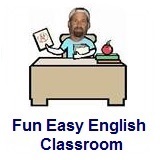 About These
Lessons About These
Lessons
The following classroom lessons are great for students
who want additional conversation, listening, and reading
practice. |
-
Conversation Lesson -
Intermediate
Level. Dialogs for everyday use.
Short situational dialogs for students of English as
a Foreign (EFL) or Second (ESL) Language with a
written conversation and a conversation notes
section.
|
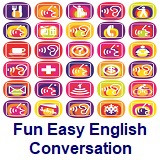 Conversation Lesson
4 - Airport Bus Conversation Lesson
4 - Airport Bus
(Intermediate -
Conversation, Reading)
Dialogs for everyday use. Short situational dialogs for
students of English as a Foreign (EFL) or Second (ESL)
Language. |
Airport Bus
Stan: What time does the bus leave for the
airport?
Harry: I don’t know. It used to leave
every half hour, but I think the schedule’s been changed.
Stan: Do you know the telephone number to
call?
Harry: It’s Enterprise 74700.
At least that’s what it used to be.
Stan: Yeah, I’ll try it. (Pause) They
don’t seem to answer.
Harry: I expect that it’s a little too
early. I don’t think they open until nine o’clock. |
|
Conversation Notes |
- At least
- In any case
- NOTE: On most telephones
in the U.S., letters appear with each number on the keypad. When those
letters are combined, we often use easy to remember words of names in place
of the letter combinations. In this example, the letters are EN which
correspond to the numbers 3 and 6. So the number here is 3674700. The use
of only numbers has become more common today.
|
|
Source: U.S. State Department |
|
Additional Conversation |
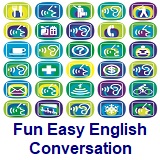 Conversation Conversation
This is a collection of 30 situational conversations
which focus on a wide variety of communicative and
natural encounters in English....these
lessons are for beginning students. |
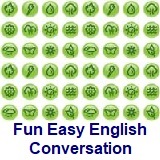 Conversation Conversation
This is a collection of 30 situational conversations. Each conversation is
accompanied by language notes....these
lessons are for advanced students. |
 Conversation Conversation
English conversation lessons. 52
lessons covering pronunciation, speaking,
writing, and grammar topics....these
lessons are for beginning students. |
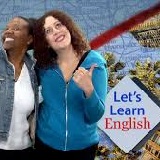 Conversation Conversation
English conversation lessons. 30
lessons focusing mostly on communication and
grammar topics....these
lessons are for intermediate students. |
|
|
|
|
|
|
|
 Hey Students, Hey Students,
Use this dictionary and reference to look up any words you do not
understand in Fun Easy English.
Note: search opens in a new tab. |
|
|
|
|
|
Search Fun Easy English |
|
|
|
|
|
|
|
|
|
|
|
|
|
|
|
About
Contact
Copyright
Resources
Site Map |